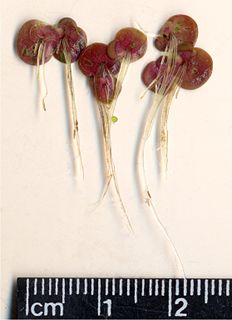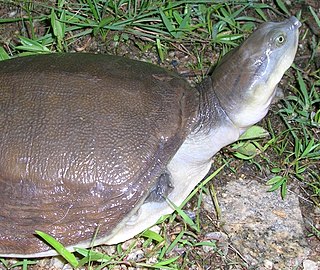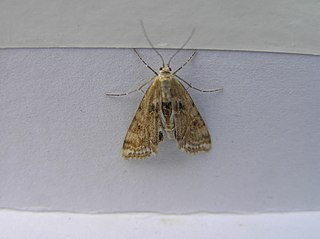
The Araceae are a family of monocotyledonous flowering plants in which flowers are borne on a type of inflorescence called a spadix. The spadix is usually accompanied by, and sometimes partially enclosed in, a spathe or leaf-like bract. Also known as the arum family, members are often colloquially known as aroids. This family of 114 genera and about 3750 known species is most diverse in the New World tropics, although also distributed in the Old World tropics and northern temperate regions.
In the scientific name of organisms, basionym or basyonym means the original name on which a new name is based; the author citation of the new name should include the authors of the basionym in parentheses. The term original combination or protonym is used in the same way in zoology. Bacteriology uses a similar term, basonym, spelled without an i.

Lemna is a genus of free-floating aquatic plants referred to by the common name "duckweed." They are morphologically divergent members of the arum family. These rapidly growing plants have found uses as a model system for studies in community ecology, basic plant biology, ecotoxicology, and production of biopharmaceuticals, and as a source of animal feeds for agriculture and aquaculture. Currently, 14 species of Lemna are recognised.

Spirodela is a genus of aquatic plants, one of several genera containing plants commonly called duckweed. Spirodela species are members of the Araceae under the APG II system. They were formerly members of the Lemnaceae.
This article gives an overview of the aquatic communities in the British National Vegetation Classification system.

Diuris, commonly known as donkey orchids, bee orchids, nanny goat orchids or pansy orchids, is a genus of more than sixty species of flowering plants in the orchid family, Orchidaceae and is endemic to Australia, apart from one species endemic to Timor. The name "Diuris" refers to the hanging sepals but the common name "donkey orchid", derives from the ear-like petals common to all species. Many have mainly yellow flowers with darker markings and are thought to mimic nectar-producing flowers which open at the same time.

Wolffia is a genus of nine to 11 species which include the smallest flowering plants on Earth. Commonly called watermeal or (mistakenly) duckweed, these aquatic plants resemble specks of cornmeal floating on the water. Wolffia species are free-floating thalli, green or yellow-green, and without roots. The flower is produced in a depression on the top surface of the plant body. It has one stamen and one pistil. Individuals often float together in pairs or form floating mats with related plants, such as Lemna and Spirodela species. Most species have a very wide distribution across several continents. Wolffia species are composed of about 40% protein on a dry-matter basis, about the same as the soybean, making them a potential high-protein human food source. They have historically been collected from the water and eaten as a vegetable in much of Asia.

Lissemys is a genus of turtles of the family Trionychidae. The genus is endemic to southern Asia. Indian flapshells are widespread and more common in South Asia.

Lemna minor, the common duckweed or lesser duckweed, is an aquatic freshwater plant of the genus Lemna. They belong to the subfamily of Lemnaceae, which are monophyletic to the family Araceae. L. minor is used as animal fodder, bioremediator, for wastewater nutrient recovery, and other applications.

Cataclysta lemnata, the small china-mark, is a moth species of the family Crambidae. It is found in Europe, Morocco and Iran.

Aplysia punctata is a species of sea slug in the family Aplysiidae, the sea hares. It reaches a length of up to 20 cm (7.9 in) and is found in the northeast Atlantic, ranging from Greenland and Norway to the Mediterranean Sea.

Halgerda is a genus of sea slugs, dorid nudibranchs, shell-less marine gastropod mollusks in the family Discodorididae.
Cerradomys scotti, also known as Lindbergh's oryzomys, is a rodent species from South America in the genus Cerradomys. It is terrestrial and is found in the cerrado (savanna) ecozone of south central Brazil, Bolivia and Paraguay. The species is common and appears to tolerate a degree of agricultural habitat modification.

The Noronha skink is a species of skink from the island of Fernando de Noronha off northeastern Brazil. It is covered with dark and light spots on the upperparts and is usually about 7 to 10 cm in length. The tail is long and muscular, but breaks off easily. Very common throughout Fernando de Noronha, it is an opportunistic feeder, eating both insects and plant material, including nectar from the Erythrina velutina tree, as well as other material ranging from cookie crumbs to eggs of its own species. Introduced predators such as feral cats prey on it and several parasitic worms infect it.
Trachylepis tschudii is an enigmatic skink, purportedly from Peru. First described in 1845 on the basis of a single specimen, it may be the same as the Noronha skink (T. atlantica) from Fernando de Noronha, off northeastern Brazil. T. tschudii represents one of two doubtful records of the otherwise African genus Trachylepis on mainland South America; the other is T. maculata from Guyana.

Spirodela polyrhiza is a species of duckweed known by the common names common duckmeat, greater duckweed, great duckmeat, common duckweed, and duckmeat. It can be found nearly worldwide in many types of freshwater habitat. It is a perennial aquatic plant usually growing in dense colonies, forming a mat on the water surface. Each plant is a smooth, round, flat disc 0.5 to 1.0 cm wide. It produces several minute roots. It also produces a pouch containing male and female flowers. The top part dies in the fall and the plant often overwinters as a turion.

Lemnoideae is a subfamily of flowering aquatic plants, known as duckweeds, water lentils, or water lenses. They float on or just beneath the surface of still or slow-moving bodies of fresh water and wetlands. Also known as "bayroot", they arose from within the arum or aroid family (Araceae), so often are classified as the subfamily Lemnoideae within the family Araceae. Other classifications, particularly those created prior to the end of the twentieth century, place them as a separate family, Lemnaceae.

Lemna aequinoctialis, the lesser duckweed, is a tiny, floating aquatic plant found in quiet waters in tropical and subtropical regions. Fronds are generally 3-nerved, green, up to 6 mm long. Flowers are 1-ovulate, the small utricular scale open on one side. Seeds have 8–26 ribs.
Elias Landolt (1926–2013) was a Swiss geobotanist, known for his publications on Switzerland's native flora and Lemnoideae.














